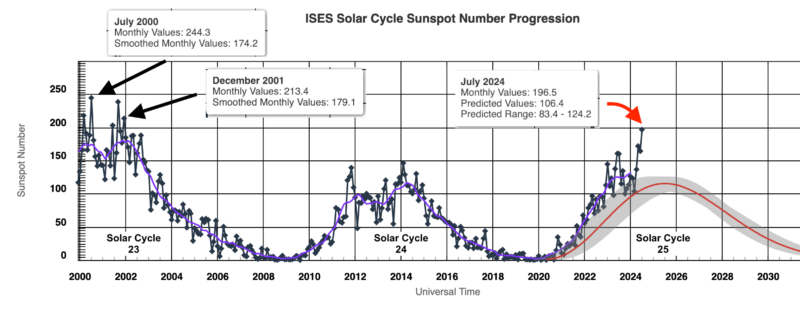
Sun news August 3: July 2024 was the peak of Solar Cycle 25 so far
Today’s top story: It is now official! The monthly average sunspot number for July 2024 was 196.5, a new high. The previous maximum for this cycle was in May 2024 with 171.7. The last time the monthly average was higher than 196.5 was 23 years ago, back in December 2001. That month saw 213 sunspots, during Solar Cycle 23. And Solar Cycle 23’s peak was 244 sunspots in July 2000 (the month of the Bastille Day Flare). The original predictions for Solar Cycle 25 (made in 2019) estimated the cycle would be approximately the same size as the previous cycle, Solar Cycle 24. However, Solar Cycle 25 has surpassed this prediction. And this past week the sun has been quite active, leading to the chance for minor-to-moderate storming and auroras tonight (according to clocks in the Americas) into tomorrow morning. Clear skies and good luck! Stay tuned for more sun news.
Last 24 hours: During the past day, solar activity dropped down to moderate with only small M flares. Between 11 UTC yesterday and 11 UTC today, our observation period, the overall flare number increased from 18 to 23, with eight M and 15 C flares. The largest flare was an M1.9 flare from active region AR3765 at 7:30 UTC on August 3. An R1 (minor) radio blackout affected an area over the Arabian Sea. The list of M flares is:
• M1.2 at 12:33 UTC on August 2 from AR3773. R1 (minor) radio blackout off the African Northwest.
• M1.1 at 13:50 UTC on August 2 from AR3775. R1 (minor) radio blackout over the Atlantic Ocean.
• M1.5 at 15:30 UTC on August 2 from AR3766. R1 (minor) radio blackout over the middle of the Atlantic Ocean.
• M1.3 at 23:58 UTC on August 2 by unnumbered NE. R1 (minor) radio blackout over west Ocean Pacific.
• M1.0 at 00:27 UTC on August 3 by unnumbered SE. R1 (minor) radio blackout over west Ocean Pacific.
• M1.5 at 04:59 UTC on August 3 by AR3770. R1 (minor) radio blackout over Laos.
• M1.5 at 07:05 UTC on August 3 from AR3768. R1 (minor) radio blackout over India.
• M1.9 at 07:30 UTC on August 3 from AR3765. R1 (minor) radio blackout over the Arabian Sea off the northwest coast of India.
Active region AR3768 is the lead flare producer of the period, with seven flares (an M and three Cs). The sun has 12 active regions on the Earth-facing side. There is a newcomer: AR3777.
Next 24 hours: The chance for C flares is 99%. The chance for M flares is 75%. The chance for X flares is 25%.
Next expected CME: Analysis and modeling of the coronal mass ejection (CME) produced during the M8.1 event by AR3768 on August 1 indicates a miss. No other Earth-bound CMEs were observed in the available chronograph imagery.
Current geomagnetic activity: Earth’s magnetic field is quiet at the time of this writing (11 UTC on August 3). A coronal mass ejection (CME) that left the sun on August 1 may arrive at Earth providing conditions for a G1-G2 (minor-moderate) geomagnetic storm on August 3 extending through August 4. This may increase the chances of auroral displays at high latitudes. Alert for aurora hunters!
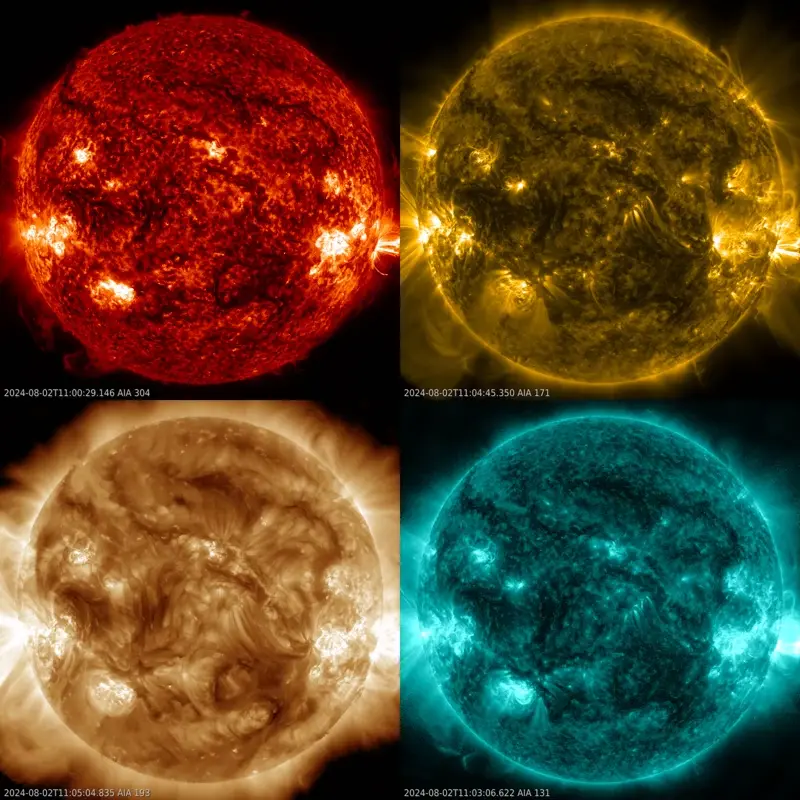



Sun news August 2: The M flares, and auroras, keep coming
What a week! Sun activity is still high. We just had another 24 hours with a fantastic number of M flares – 15 M flares in the past day including an M7.4 (almost an X flare). The sun is now peppered with sunspot regions on its Earth-facing side. In addition to all the sun action, more sun stuff that left our star during yesterday’s large flare is headed Earth’s way, adding to the chance for geomagnetic storming and auroras. Tonight (according to clocks in the Americas) into tomorrow morning, minor-to-moderate storming and auroras are expected. Clear skies and good luck! Stay tuned for more sun news.
Last 24 hours: The 15 M flares of the past day has kept sun activity high. Most of them were small M flares, but one of them, the largest, was an M7.4. Between 11 UTC and 11 UTC today, the sun produced a total of 18 flares: 15 M and four C flares. The largest flare, the M7.4, was a long-duration event that peaked at 4:55 UTC on August 2 from AR3768. It produced an extended R2 (moderate) radio blackout that affected an area starting in Taiwan in the Philippine Sea at around 4:23 UTC and extended through 6:13 UTC on August 2, affecting an area over Myanmar. The list of M flares is:
• M4.1 at 11:37 UTC on August 1 from AR3772. R1 (minor) radio blackout the African Northwest.
• M4.2 at 11:47 UTC on August 1 from AR3772. R1 (minor) radio blackout over the Northwest Africa.
• M1.1 at 16:15 UTC on August 1 from AR3764. R1 (minor) radio blackout over the Dominican Republic.
• M1.3 at 16:37 UTC on August 1 from AR3768. R1 (minor) radio blackout over Cuba.
• M1.6 at 16:47 UTC on August 1 from AR3774. R1 (minor) radio blackout over Cuba.
• M1.3 at 17:29 UTC on August 1 from AR3772. R1 (minor) radio blackout over Cuba.
• M1.2 at 20:22 UTC on August 1 from AR3774. R1 (minor) radio blackout over the Pacific Ocean.
• M1.4 at 23:08 UTC on August 1 from AR3774. R1 (minor) radio blackout over the Pacific Ocean.
• M1.0 at 02:01 UTC on August 2 from AR3765. R1 (minor) radio blackout over the Philippine Sea.
• M1.1 at 03:25 UTC on August 2 from AR3772. R1 (minor) radio blackout over the Philippine Sea.
• M1.2 at 03:58 UTC on August 2 from AR3768. R1 (minor) radio blackout over the Philippines.
• M7.4 at 04:55 UTC on August 2 from AR3768. R2 (moderate) radio blackout over China. Largest event
• M2.2 at 07:59 UTC on August 2 from AR3765. R1 (minor) radio blackout over Oman.
• M1.2 at 09:16 UTC on August 2 from AR3772. R1 (minor) radio blackout over the Middle East.
• M1.6 at 09:51 UTC on August 2 from AR3766. R1 (minor) radio blackout over the Middle East.
Active region AR3774 remains the lead flare producer. This time with five flares (three Ms and two Cs). Today, five active regions on the Earth-facing solar disk show a delta magnetic region, three of them, AR3765, AR3768 and AR3772 have a beta-gamma-delta magnetic complexity. In contrast, AR3767 and AR3770 have a beta-delta configuration. AR3766, AR3774, and AR3775 show a beta-gamma configuration, and the rest of the sunspot regions show alpha or beta. The sun has 12 active regions on the Earth-facing side. There is a newcomer: AR3776.
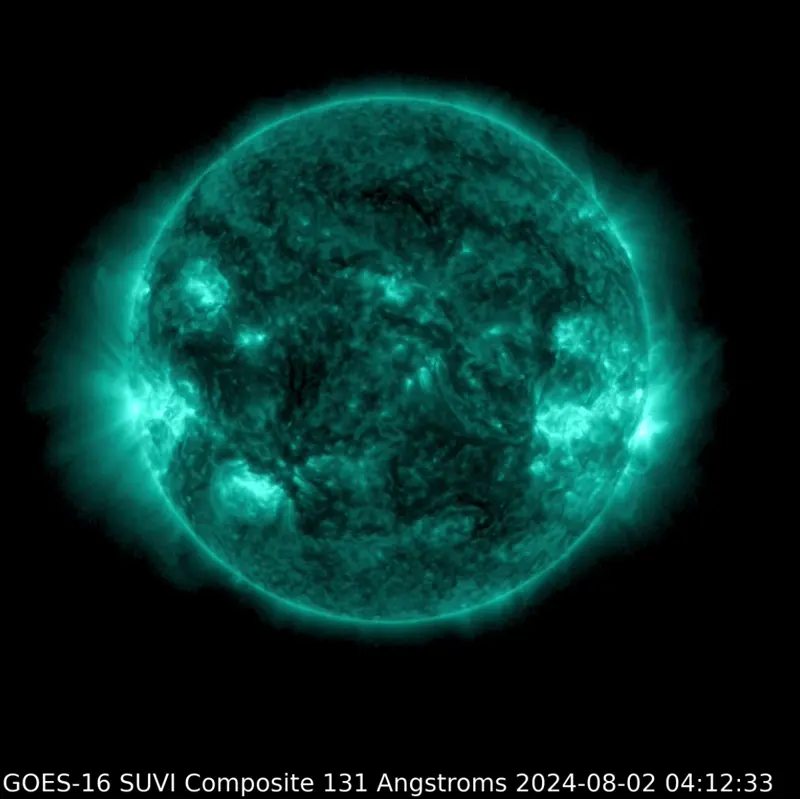
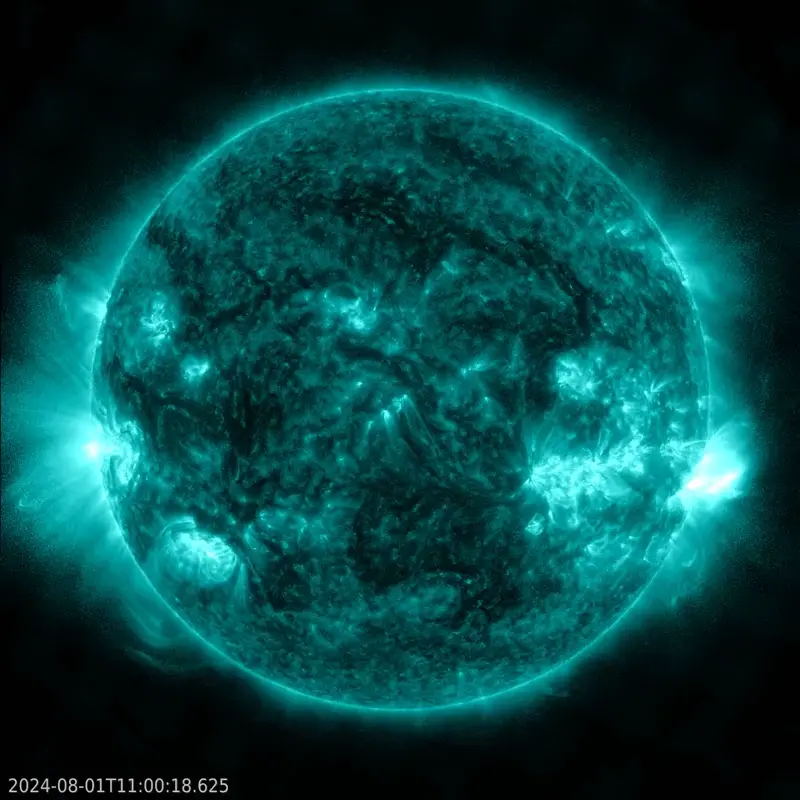
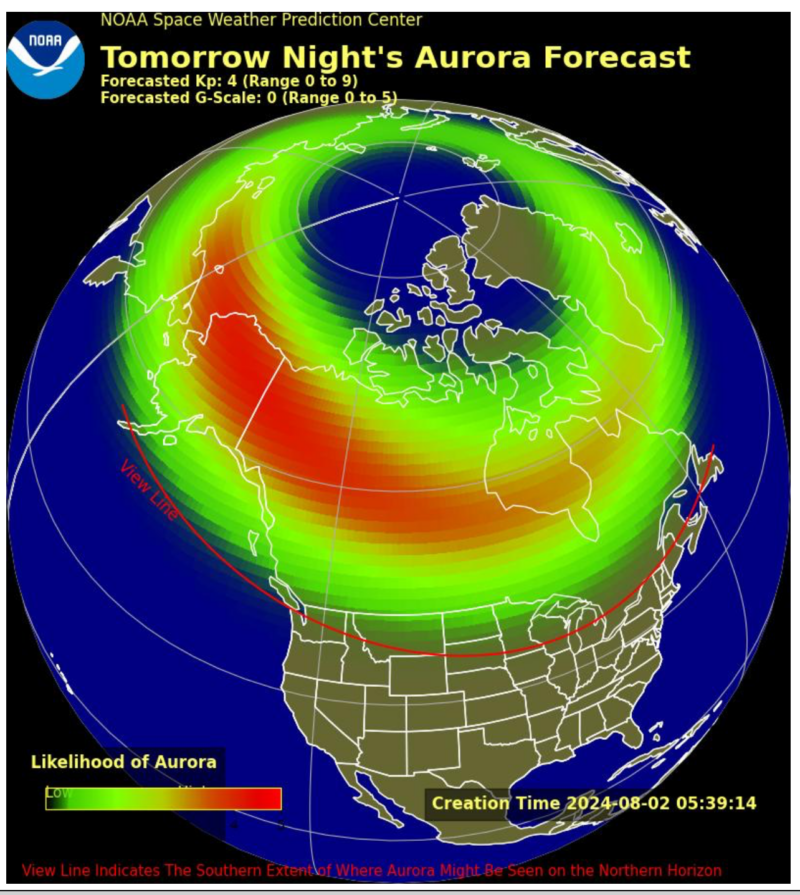
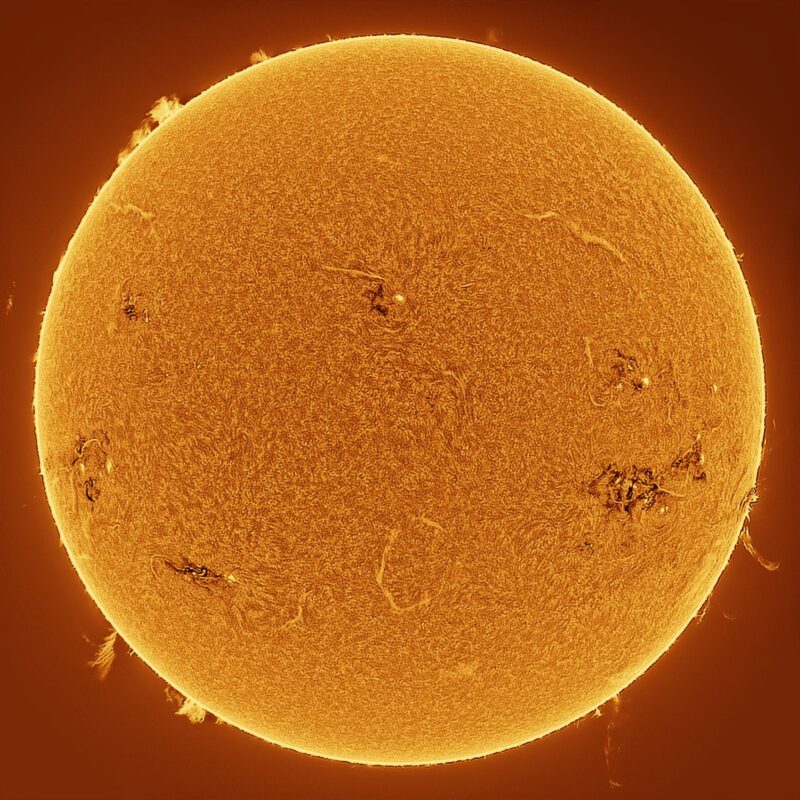
Sun news August 1: Activity is still high! Tons of M flares
This week’s high sun activity continues, with an impressive 15 M flares from several sunspot regions blasted over the past 24 hours. And it looks like the action will keep on coming. We can currently see a handful of sunspot groups with delta regions, which means they have the potential for major flaring. Plus the old region AR3738 (now AR3774) is back on the Earth-facing sun, having fired an incredible X14 flare while on the sun’s reverse, and is starting to come into full view. And to add to the excitement, more geomagnetic storming is forecast for tonight, so auroras could be on the way for those at higher latitudes! Stay tuned.
Last 24 hours: Sun activity is high after 15 M flares were fired over the past day, three of them above M5. Between 11 UTC and 11 UTC today, the sun produced 23 flares: 15 Ms and 8 C flares. The largest flare was an M8.1 at 7:08 UTC on August 1 from AR3768. The list of M flares is:
• M6.0 by 13:05 UTC on July 31 from AR3772. R2 (moderate) radio blackout over the Atlantic Ocean.
• M4.4 at 13:32 UTC on July 31 from AR3774. R1 (minor) radio blackout over the Atlantic Ocean off the coast of Africa.
• M1.4 at 16:31 UTC on July 31 from AR3774. R1 (minor) radio blackout over the Dominican Republic.
• M5.4 at 18:37 UTC on July 31 from AR3756. R2 (moderate) radio blackout over Mexico.
• M1.3 at 21:55 UTC on July 31 from ARAR3767. R1 (minor) radio blackout over Hawaii.
• M1.0 at 22:50 UTC on July 31 AR3774. R1 (minor) radio blackout over the Pacific Ocean off the coast of Hawaii.
• M1.2 at 0:58 UTC on August 1 from AR3770. R1 (minor) radio blackout over the Pacific Ocean.
• M6.3 at 1:50 UTC on August 1. from AR3773. R2 (moderate) radio blackout over the Philippine Sea.
• M1.0 at 2:25 UTC on August 1 from AR3762. R1 (minor) radio blackout over the Philippine Sea.
• M1.2 at 3:06 UTC ON August 1 from AR3774. R1 (minor) radio blackout over the Philippine Sea.
• M2.0 at 4:16 UTC on August 1 from AR3774. R1 (minor) radio blackout over Taiwan.
• M4.0 at 4:41 UTC on August 1 from AR3765. R1 (minor) radio blackout over Hong Kong.
• M1.5 at 5:56 UTC on August 1 from AR3765. R1 (minor) radio blackout over Myanmar.
• M1.3 at 6:06 UTC on August 1 from AR3768. R1 (minor) radio blackout over Bangladesh.
• M8.1 at 7:08 UTC on August 1 from AR3768. R2 (moderate) radio blackout over Africa. The largest.
Active region AR3774 was the lead flare producer with nine flares (four Ms and five Cs). Today, four active regions on the Earth-facing solar disk have a delta magnetic region. AR3765 and AR3768 have a beta-gamma-delta magnetic complexity while AR3767 and AR3770 have a beta-delta configuration. AR3762, AR3766 and AR3774 show a beta-gamma configuration, and the rest of the sunspot regions are showing alpha or beta. The sun has 12 active regions on the Earth-facing side. There is a newcomer: AR3775.

Sun news July 31: Sunspot region blasted an X14! Now it’s back
Sun activity is high this week, so far. There were 7 M flares in the past day. And check out the newcomer on the sun’s eastern, or incoming, side. Remember sunspot region AR3738? It produced an X flare and numerous M and C flares during its trip across the Earth-facing sun from July 5 to 17. Then the sun’s rotation carried it to the far side, where it produced an X14 flare! The flare – and its effects – were observed thanks to the Solar Orbiter spacecraft, which can see the sun’s far side even when we on Earth can’t. But guess what? The sun has kept on spinning. And now this powerful region is back in view! It has a new number: AR3774. The renumbered region produced an M4.8 before being labeled and fully in view. We wait to see if it will live up to its earlier incarnations. Meanwhile, it has competition from AR3772, which produced an almost-X flare over the past day, an M9.4. And region AR3768 just gave us an M7.7. There is a lot of magnetic potential on the Earth-facing solar disk right now. So there’s great potential for M and X flares. This is exciting, because we have already had an active sun with several good-sized M flares over the last few days. That means more CMEs are on the way, with perhaps more to come even as we wait for the train of solar blobs – the incoming coronal mass ejections, or CMEs – that are already expected at any moment (see Current Geomagnetic Activity, below). Stay tuned, sun-watchers and aurora-watchers. Get your gear ready. Clear skies to all!
Last 24 hours: In the past day (11 UTC yesterday to 11 UTC today), sun activity stayed at high levels thanks to seven M flares, including an M9.4 and an M7.7. The flares during our observation period (11 UTC yesterday to 11 UTC today) included seven M flares and eight C flares. The largest event of the period was the M9.4 at 19:38 UTC on July 30 from AR3772. The complete M flare list is:
• M1.5 at 16:28 UTC on July 30 from AR3766. R1 (minor) radio blackout over the Dominican Republic.
• M1.9 at 19:20 UTC on July 30 from AR3764. R1 (minor) radio blackout over the Mar de Cortés.
• M9.4 at 19:38 UTC on July 30 AR3772. R2 (moderate) radio blackout over the Pacific Ocean.
• M3.1 at 20:19 UTC on July 30 from AR3772. R1 (minor) radio blackout over the Pacific Ocean.
• M2.0 at 1:50 UTC on July 31 from AR3773. R1 (minor) radio blackout over the Philippine Sea.
• M4.8 at 5:23 UTC on July 31 from AR3774. R1 (minor) radio blackout over Myanmar.
• M7.7 at 6:46 UTC on July 31 from AR3768. R2 (moderate) radio blackout over India.
Active region AR3764 was the lead flare producer of the day with four flares, an M, and three C flares. Three active regions on the Earth-facing solar disk keep a delta magnetic region. AR3765 and AR3768 have a beta-gamma-delta magnetic complexity and AR3770 has a beta-delta complexity. AR3762 and AR3766 have a beta-gamma configuration, while the rest of the sunspot regions show an alpha or beta. Currently, the sun has 12 labeled active regions on the Earth-facing side. There are three newcomers: AR3772, AR3773, and the just labeled AR3774.
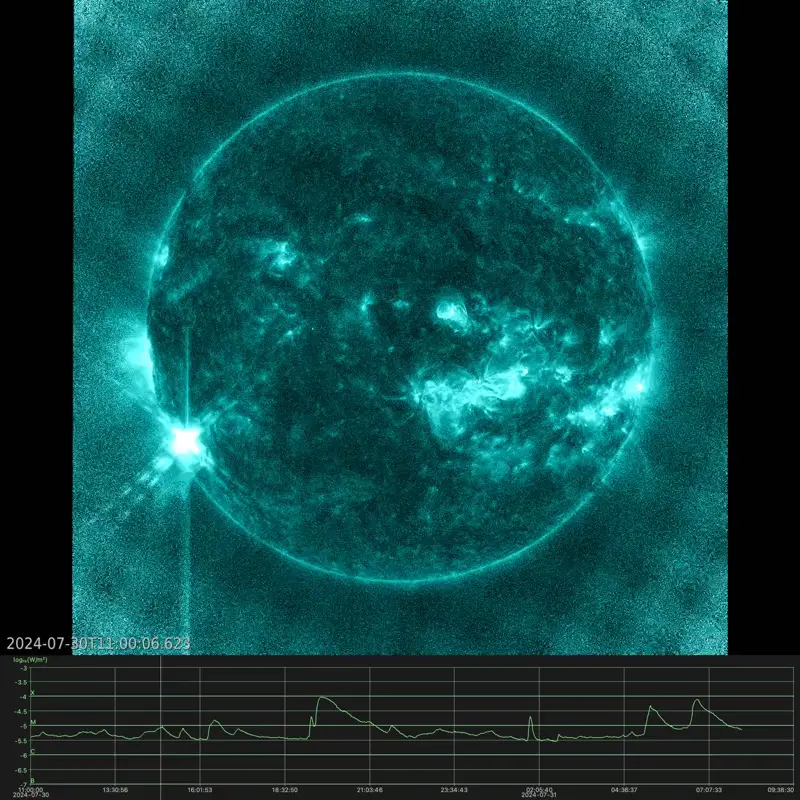
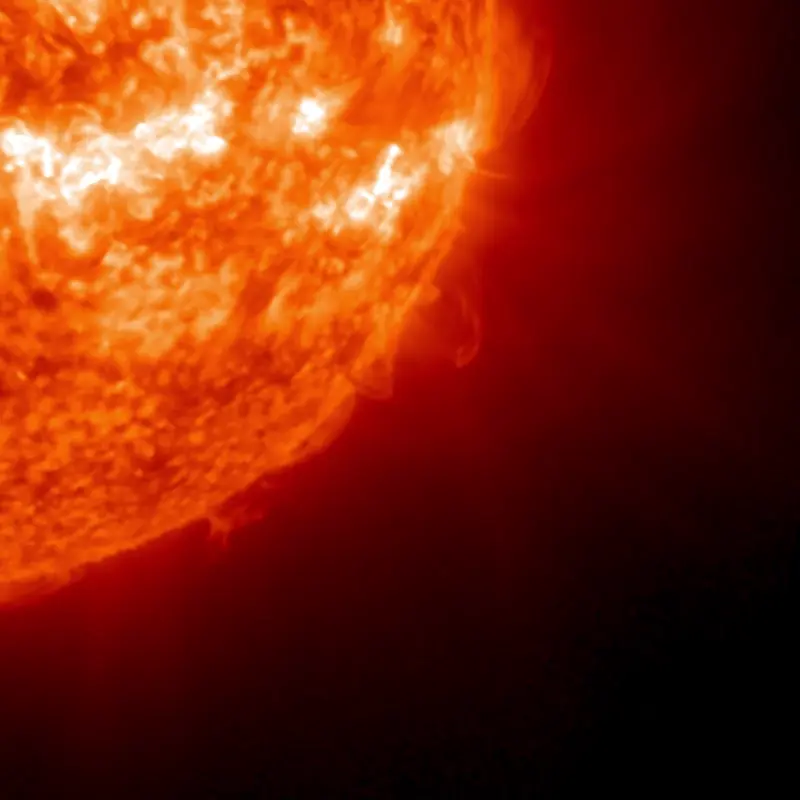
Sun news July 30: ‘Strong’ geomagnetic storm watch
A chunk of solar stuff hit Earth earlier today. Earth’s geomagnetic field reached the G1 (minor) storm threshold at 3 UTC on July 30 (late last night according to clocks in the Americas). And more is ahead today, especially for those in Europe. Spaceweather forecasters are calling for G1-G2 (minor-moderate) geomagnetic storming up to a G3 (strong) during the rest of today. The G3 storm is expected when the Americas are still in daylight. Will it last into tonight according to American clocks? Maybe. And will the storming be as extreme as those seen in May 2024 which caused auroras even as far south as our latitude here in Texas? Probably not. That was a G5 (extreme) event. Today’s event is predicted for G3 (strong). It is being caused by multiple coronal mass ejections (CMEs) hurled from the sun during July 28-29. Stay alert, aurora chasers! Bring those cameras out, take all those beautiful photos, and share them with the EarthSky community. The Enlil model shows four CMEs released in the past few days by our star. It created a cannibal CME, which is expected to reach Earth on July 31-August 1. Get ready for some aurora-watching. This is certainly true for higher latitudes, but it could also be true for northern-tier U.S. states. Stay tuned for updates.
Last 24 hours: Nine M flares, one of them an M8.7 flare and another one an M6.4 kept sun activity at high levels in the past day. Solar flaring activity during our observation period (11 UTC yesterday to 11 UTC today) was 18 flares, nine M flares and 11 C flares. The largest event of the period was an M8.7 at 12:55 UTC on July 29 from AR3762. The complete M flare list is:
•M1.6 at 12:22 UTC on July 29 by AR3762. R1 (minor) radio blackout over the Atlantic Ocean.
• M8.7 at 12:55 UTC on July 29 by AR3762. R2 (moderate) radio blackout over the Atlantic Ocean.
• M4.3 at 14:46 UTC on July 29 by unnumbered incoming region. R1 (minor) radio blackout over the Atlantic Ocean.
• M6.4 at 19:57 UTC on July 29 by unnumbered incoming region. R2 (moderate) radio blackout over the Pacific Ocean off the west coast of Baja in Mexico.
• M1.1 at 21:00 UTC on July 29 by AR3768. R1 (minor) radio blackout over the Pacific Ocean.
• M1.7 at 1:03 UTC on July 30 by AR3762. R1 (minor) radio blackout over the middle of the Pacific Ocean.
• M1.2 at 1:25 UTC on July 30 by AR3762. R1 (minor) radio blackout over the Philippine Sea.
• M1.3 at 1:32 UTC on July 30 by AR3768. R1 (minor) radio blackout over the Philippine Sea.
• M1.5 at 6:29 UTC on July 30 by AR3766. R1 (minor) radio blackout over northeast India.
AR3768 was the lead flare producer with five flares, including two M flares and three C flares. Two active regions on the solar disk, AR3766 and AR3768, have beta-gamma-delta magnetic complexity. AR3765 and AR3770 also gained a beta-delta magnetic complexity while AR3762 keeps a beta-gamma configuration. The remaining 10 labeled active regions on the sun’s Earth-facing side have an alpha or a beta complexity. There is a newcomer that emerged just below the equator in the southwest quadrant now numbered AR3771.

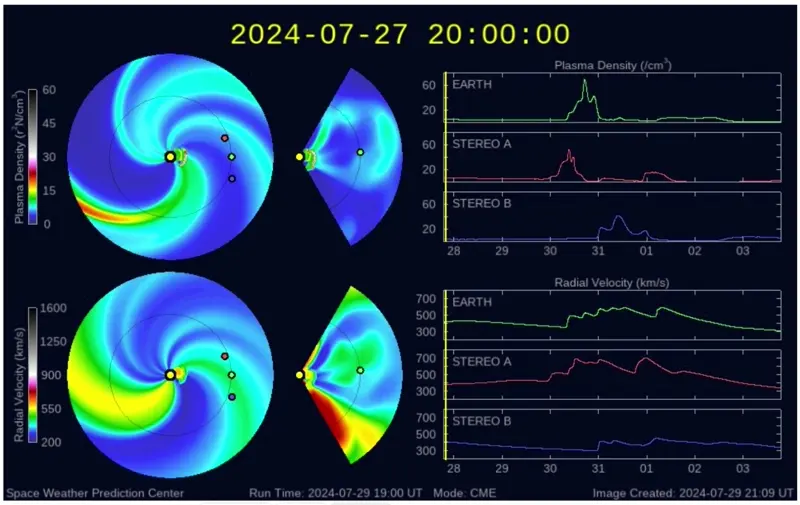
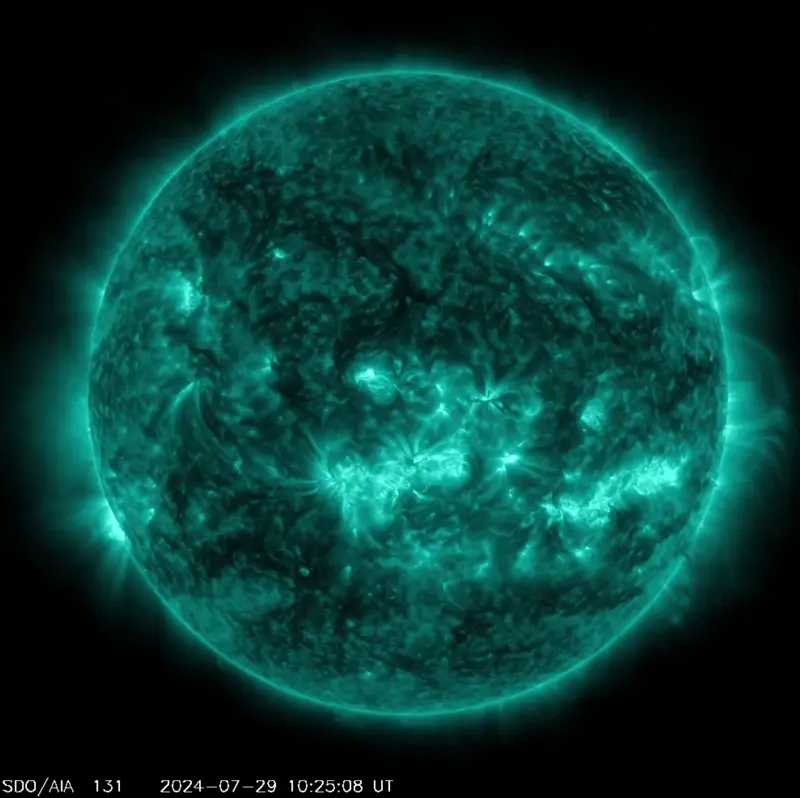
Sun news July 29: KaBOOM! X1.5 flare and sun stuff on the way
The sun released an X1.5 solar flare early this morning (2:33 UTC on July 29). This flare, along with many of the M flares over the past two days, has a coronal mass ejection (CME) associated with it. CMEs from July 27 and July 28, mentioned in the video below, created a cannibal CME, which is expected to reach Earth on July 31-August 1. We await the space weather forecaster analysis of the CMEs for the past 24 hours, but there are more than likely a few more on the way to Earth’s vicinity. With all of these CMEs and their resulting (expected) geomagnetic storms, it’s a good time to get ready for some aurora-watching. This is certainly true for higher latitudes, but it could also be true for northern-tier U.S. states. Stay tuned for aurora forecast updates.
Last 24 hours: Sun activity is high. Solar activity increased slightly over the past 24 hours (11 UTC yesterday to 11 UTC today). The sun produced an X1.5 flare, six M, and ten C flares. The largest event of the period was an X1.5 at 2:33 UTC on July 29. The complete list of X and M flares is:
• M1.7 on July 28 at 11:28 UTC from AR3762. R1 (minor) radio blackout over the Atlantic Ocean.
• M2.6 on July 28 at 12:43 UTC from AR3767. R1 (minor) radio blackout over the Atlantic Ocean.
• M1.7 on July 28 at 13:46 UTC from AR3768. R1 (minor) radio blackout over the Atlantic Ocean.
• M1.3 on July 28 at 18:08 UTC from AR3768. R1 (minor) radio blackout over the U.S.
• M1.9 on July 28 at 20:25 UTC from AR3762. R1 (minor) radio blackout over the Pacific Ocean.
• X1.5 on July 29 at 02:33 UTC from AR3764. R3 (strong) radio blackout over East Asia.
• M1.0 on July 29 at 05:10 UTC from AR3768. R1 (minor) radio blackout over East Asia.
AR3762 produced the most M flares, with five. AR3767 produced four and AR3768 produced three. AR3763-65 and AR3770 all increased slightly in size. AR3762, 68, and 69 decreased sightly in size. AR3762 maintained its beta-gamma-delta magnetic complexity. AR3765 and 68 also gained beta-gamma-delta magnetic complexity. AR3764, AR3766, and AR3770 have beta-gamma complexities. The remaining have alpha or beta. The sun has ten sunspot regions on the Earth-facing disks.
? Sun news July 29: KaBang! X1.5 flare and sun stuff on the way
? ? KaBang! An X1.5 solar flare was released early this morning at 2:33 UTC on July 29. This flare, along with many of the flares, has CMEs associated with them.
? MORE at EarthSky: https://t.co/xD29wLfm4e pic.twitter.com/YWZihs48VM
— Dr. C. Alex Young (@TheSunToday) July 29, 2024
Sun news for July 27-28, 2024. CMEs from July 26 and July 27 are combining to form a cannibal CME. That is, the 2nd, faster CME should overtake the first CME, and the combination might give Earth a grand display of auroras. Will it affect our power grids? Follow this link to learn about the solar flare HOTLINE.
The sun in recent days
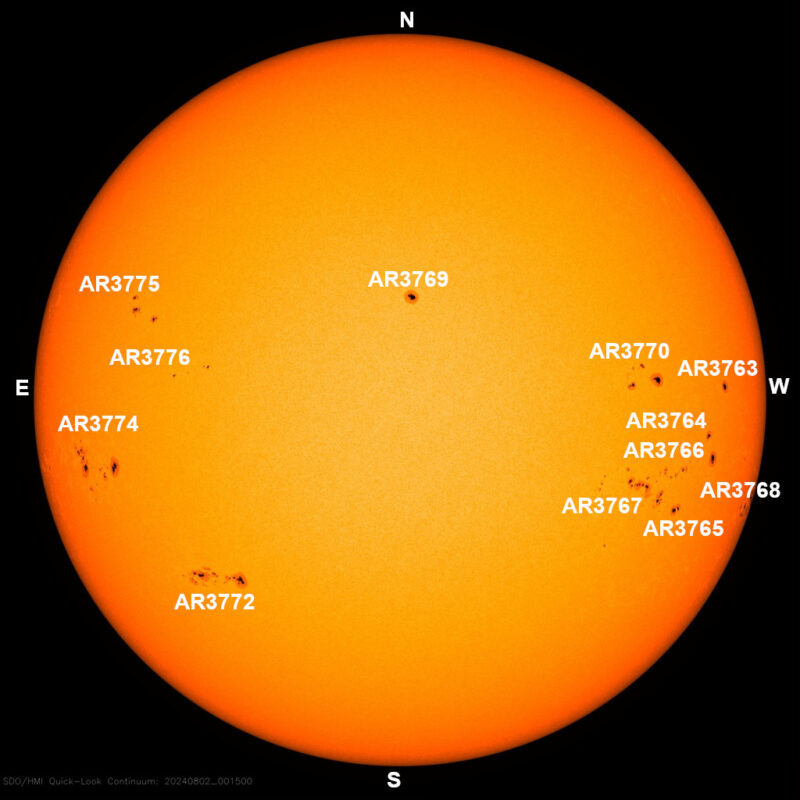
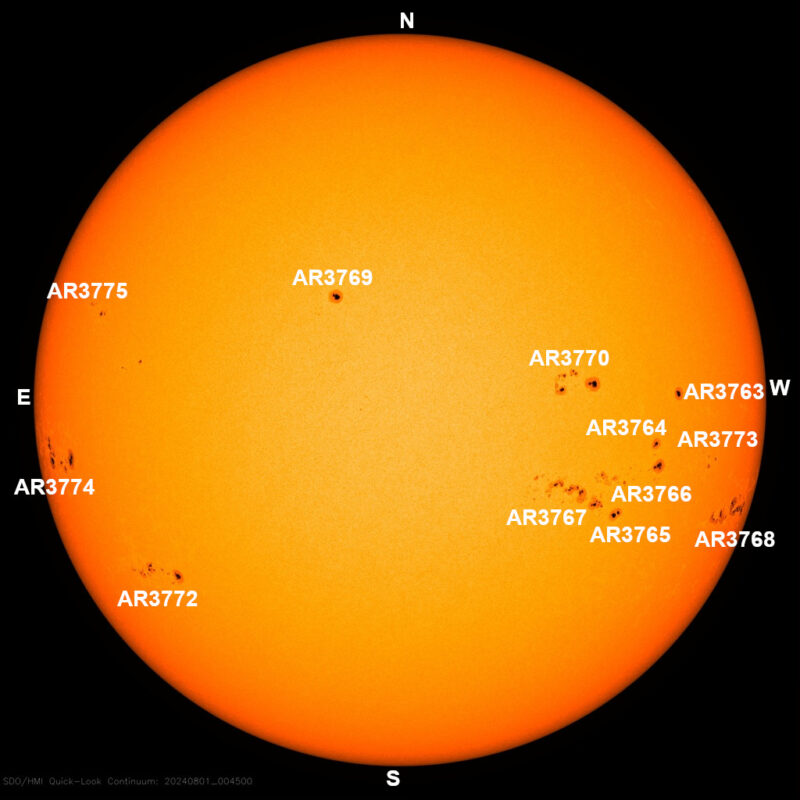
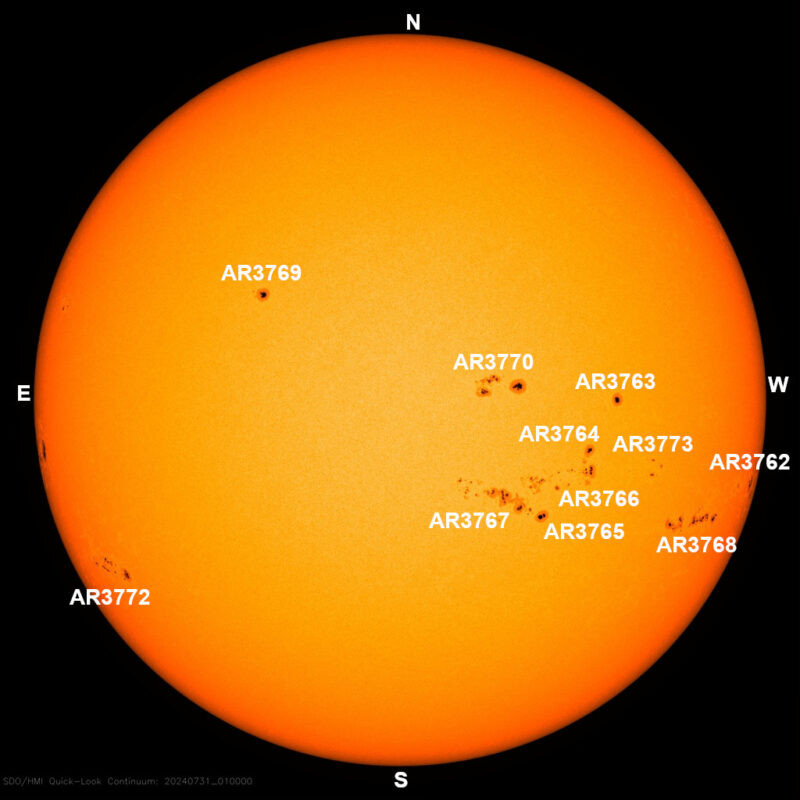
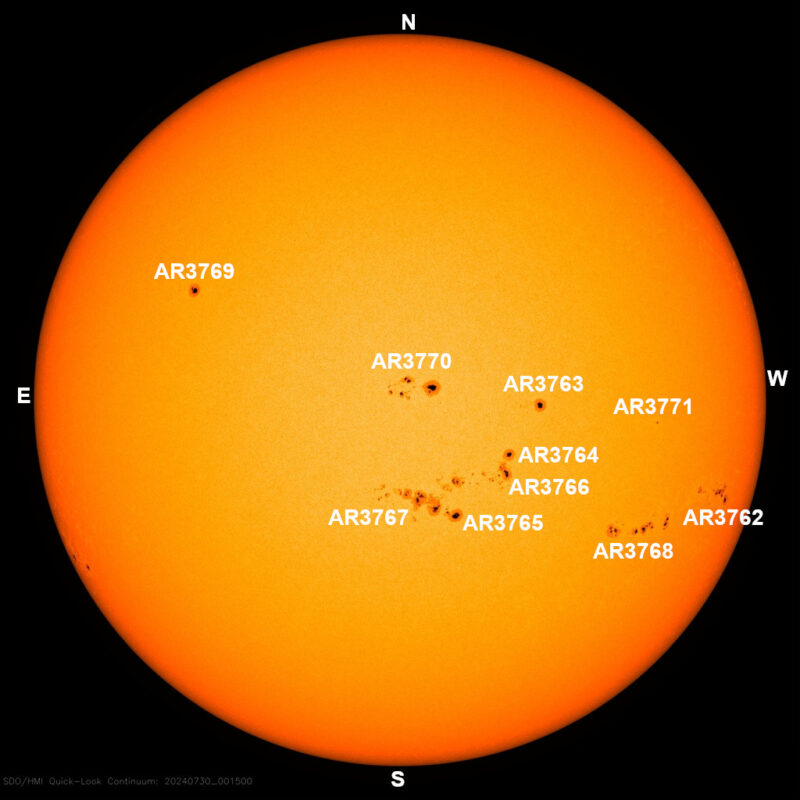
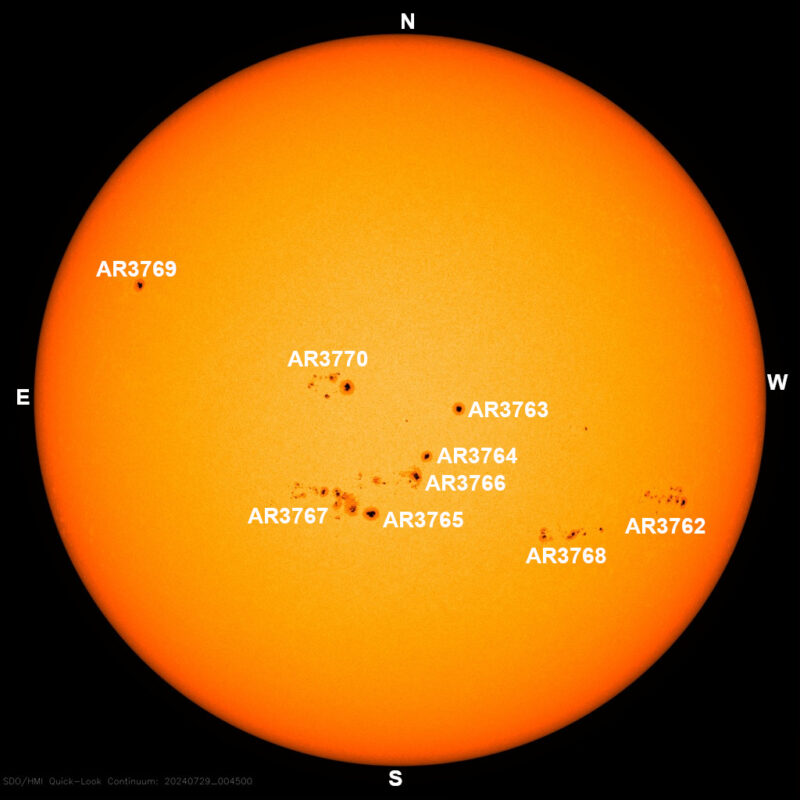
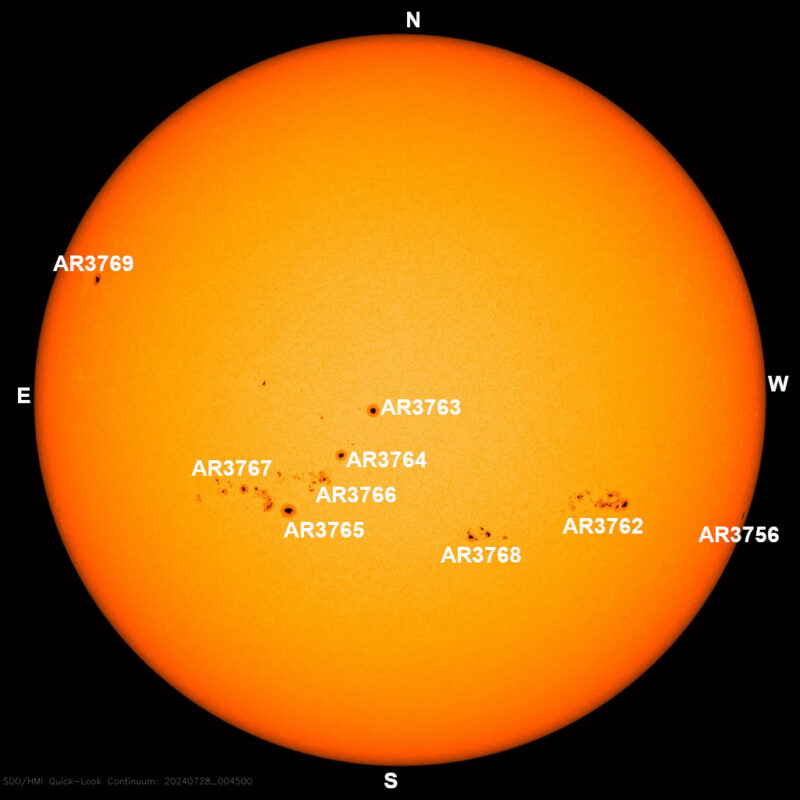

Sun images from our community
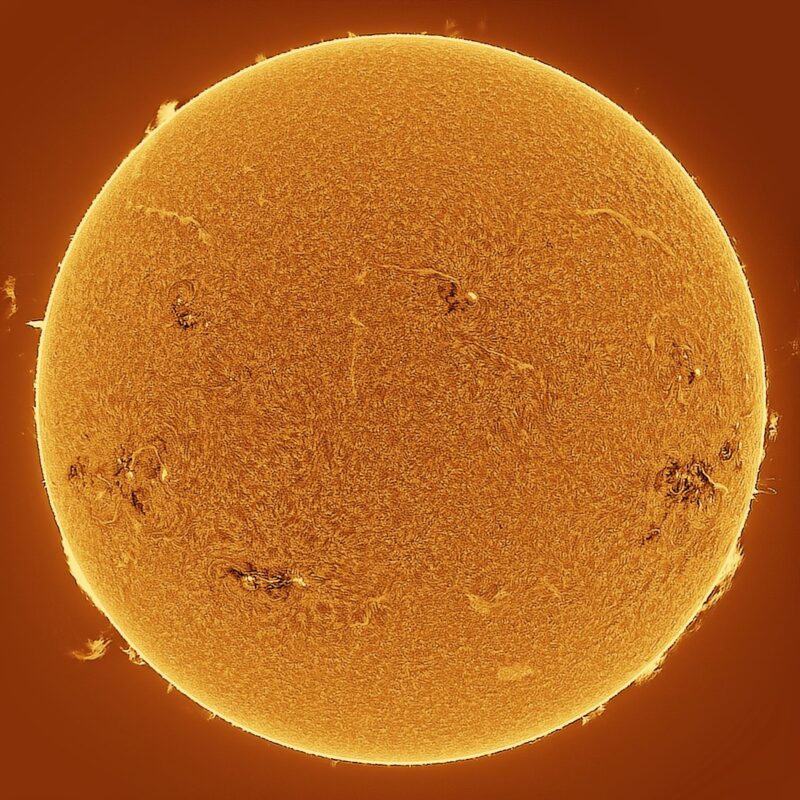
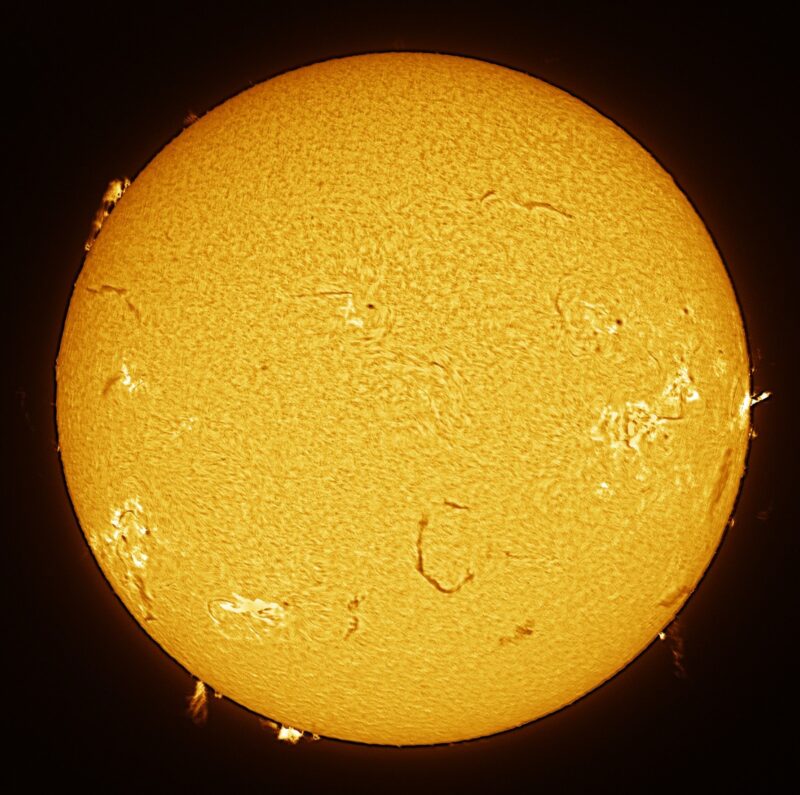

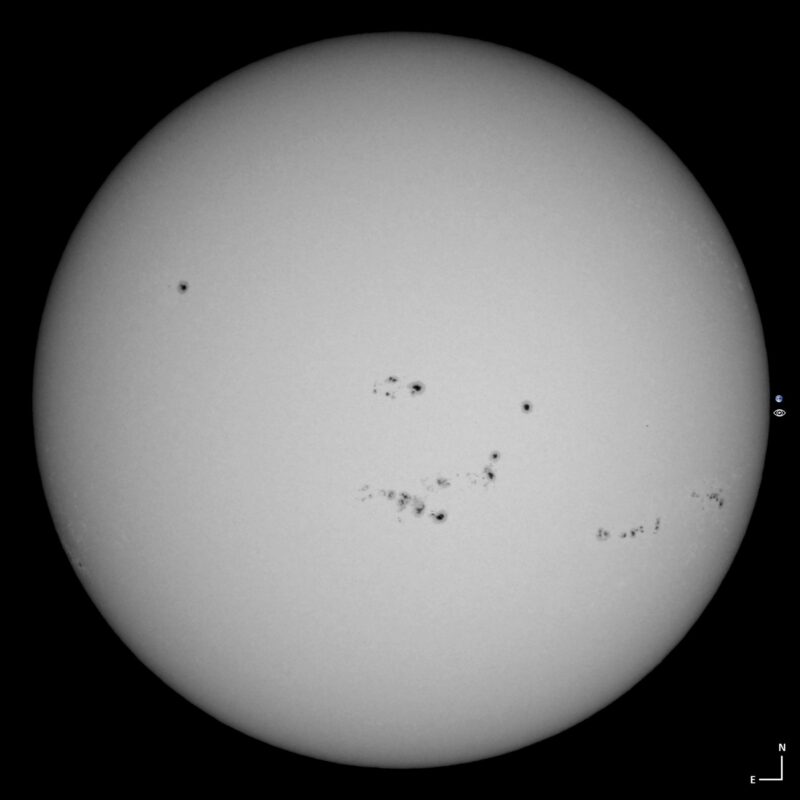
Are you a fan of sun images? We invite you all to send us your beautiful recent photos of sunspots and auroras. We love receiving them and sharing them! And to those of you who’ve already posted a photo to our community page, thank you.
Bottom Line: Sun news for August 3, 2024: Sun activity is moderate. July 2024 now holds the record for Solar Cycle 25’s highest monthly average sunspot.











